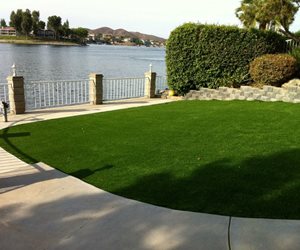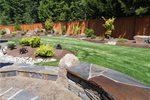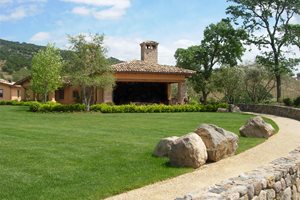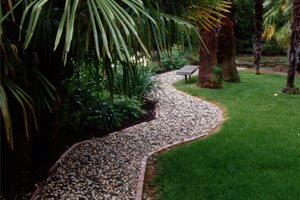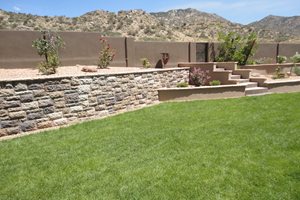Lawn Drainage Systems for Fixing a Soggy Lawn
How to prevent and fix common drainage issuesFixing a Soggy Lawn
Northwest Backyard Retreat
See how this backyard’s soggy lawn was fixed using sub-surface drainage designed to carry water away from the grass.
Drainage and grading are an obvious concern in rainy climates, but even in areas with little rainfall, proper grading can prevent problems such as water puddling in the landscape or draining towards the foundation. Here, landscaping professionals share their advice for solving common drainage and grading issues in and around the lawn.
Types of drain systems
- Grassy swale.
A swale is an area of the lawn which is carefully graded to direct water. “A swale need not be obvious,” says Mark Paine of Sposato Landscape in Milton, DE. “As little as a 1 inch drop every 10 feet will provide enough flow for it to be effective.” A swale helps dissipate water over a larger area, or directs the water to a bog planting or a drain. - Bog area in landscape.
Landscaping plants can be a great drainage solution for areas with a small amount of excess water. Red-twig dogwoods, willows, and many native plants in each region are well-adapted to periodic bog conditions. - French drain.
A French drain is the most well-known type of outdoor drainage system. While the specifics vary, a French drain is usually comprised of a perforated pipe which is surrounded by gravel then wrapped in filter fabric to keep mud and particles out. A French drain directs water to a drain rather than dispersing it within the landscape. - Dry well system.
Paine recommends a newer type of drainage system called a dry well. A dry well is an environmentally-friendly alternative to a French drain, because it discharges the storm water on-site. Downspouts or drains are directed to an underground storage well. The water slowly filters out of the well and eventually ends up back in the groundwater tables. Paine has used the NDF Flow-Well Dry Well system to great success, and recommends it as a more cost-effective solution than a French drain (compare the cost of various drainage systems). - Corrugated plastic tubes.
This is an inexpensive solution for directing water from downspouts. It’s simply a corrugated tube made of plastic which sits over the end of the downspout and can be buried underground to direct water within the landscape to disburse, or to a drain.
Drainage problems and solutions
Downspouts
Problem:
One of the most common issues in the landscape is when downspouts don’t have any place to drain. Daniel McClure of LKM Mowing and Landscaping in Normal, IL says, “When the water from downspouts isn’t directed anywhere, you get dying plants in the landscape. Most plants dislike having soupy feet.”
Solution:
“Previously, the standard procedure was to put in corrugated drain tile and send water from downspouts to the drain,” says McClure. “Now, many people elect to direct drainage over a grassy swale in the lawn to an overflow area planted with water-loving natives.” Plastic corrugated tubes are another option for directing downspout drainage.
Grade changes
Problem:
Many people are oblivious to what is happening just outside their garden fence. Even the best neighbors can inadvertently direct water onto your property and cause a drainage issue.
Solution:
Some neighbors opt to share the cost of an underground drainage system such as a French drain or a dry well to divert water to a more appropriate location, such as the city sewer service or an area of the landscape where the water won’t do any harm.
Moisture in basement
Problem:
If your lawn or landscape has a slope, or has been improperly graded so that water flows towards your foundation, you may end up with excess moisture in your basement.
Solution:
The best solution is prevention. “Always grade so that water flows away from houses, landscaped beds, and your neighbor, too,” says Paine. If a large slope is the problem, an underground drainage system such as a French drain or a dry well system will be your best bet. These drainage systems are often combined with a sump pump for extra effectiveness.

 Backyards
Backyards
 Front Yards
Front Yards
